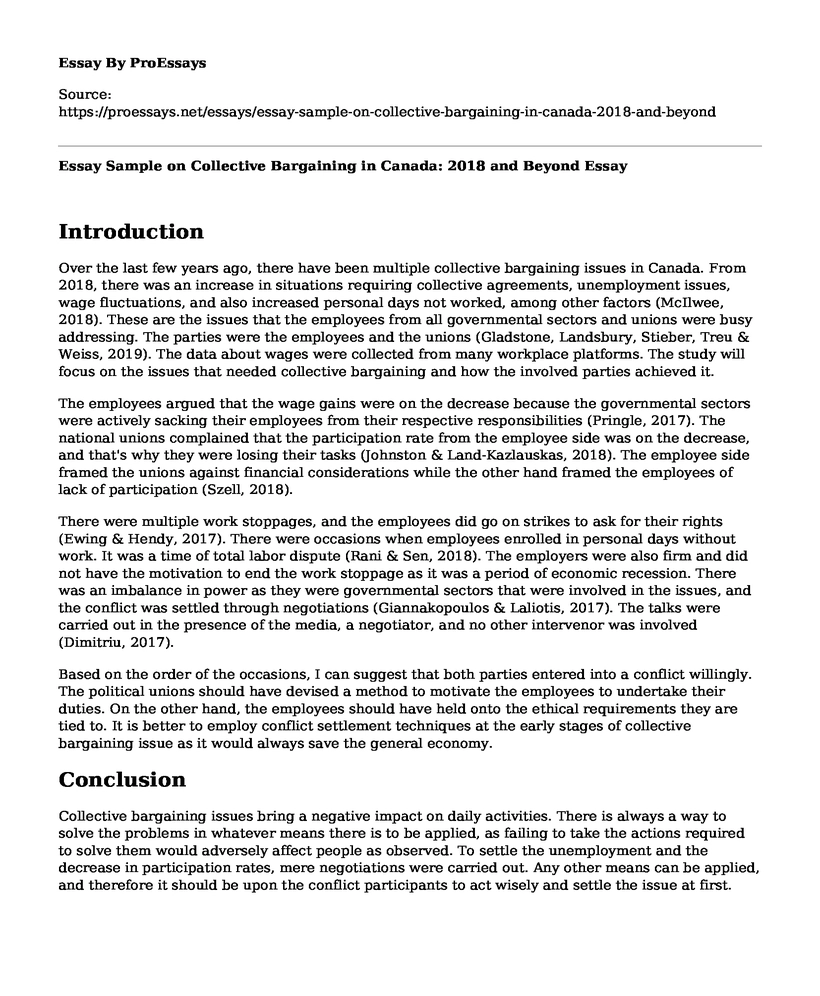Introduction
Over the last few years ago, there have been multiple collective bargaining issues in Canada. From 2018, there was an increase in situations requiring collective agreements, unemployment issues, wage fluctuations, and also increased personal days not worked, among other factors (McIlwee, 2018). These are the issues that the employees from all governmental sectors and unions were busy addressing. The parties were the employees and the unions (Gladstone, Landsbury, Stieber, Treu & Weiss, 2019). The data about wages were collected from many workplace platforms. The study will focus on the issues that needed collective bargaining and how the involved parties achieved it.
The employees argued that the wage gains were on the decrease because the governmental sectors were actively sacking their employees from their respective responsibilities (Pringle, 2017). The national unions complained that the participation rate from the employee side was on the decrease, and that's why they were losing their tasks (Johnston & Land-Kazlauskas, 2018). The employee side framed the unions against financial considerations while the other hand framed the employees of lack of participation (Szell, 2018).
There were multiple work stoppages, and the employees did go on strikes to ask for their rights (Ewing & Hendy, 2017). There were occasions when employees enrolled in personal days without work. It was a time of total labor dispute (Rani & Sen, 2018). The employers were also firm and did not have the motivation to end the work stoppage as it was a period of economic recession. There was an imbalance in power as they were governmental sectors that were involved in the issues, and the conflict was settled through negotiations (Giannakopoulos & Laliotis, 2017). The talks were carried out in the presence of the media, a negotiator, and no other intervenor was involved (Dimitriu, 2017).
Based on the order of the occasions, I can suggest that both parties entered into a conflict willingly. The political unions should have devised a method to motivate the employees to undertake their duties. On the other hand, the employees should have held onto the ethical requirements they are tied to. It is better to employ conflict settlement techniques at the early stages of collective bargaining issue as it would always save the general economy.
Conclusion
Collective bargaining issues bring a negative impact on daily activities. There is always a way to solve the problems in whatever means there is to be applied, as failing to take the actions required to solve them would adversely affect people as observed. To settle the unemployment and the decrease in participation rates, mere negotiations were carried out. Any other means can be applied, and therefore it should be upon the conflict participants to act wisely and settle the issue at first.
References
McIlwee, T. (2018). Collective bargaining. In European Labour Relations (pp. 14-16). Routledge.
Gladstone, A., Landsbury, R., Stieber, J., Treu, T., & Weiss, M. (Eds.). (2019). Current issues in labor relations: an international perspective. Walter de Gruyter GmbH & Co KG.
Pringle, T. (2017). A class against capital: Class and collective bargaining in Guangdong. Globalizations, 14(2), 245-258.
Johnston, H., & Land-Kazlauskas, C. (2018). Organizing on-demand: Representation, voice, and collective bargaining in the gig economy. Conditions of work and employment series, 94.
Szell, G. (2018). European Labour Relations: Volume I-Common Features. Routledge.
Ewing, K., & Hendy, J. (2017). New perspectives on collective labor law: Trade union recognition and collective bargaining. Industrial Law Journal, 46(1), 23-51.
Rani, U., & Sen, R. (2018). Labour relations and inclusive growth in India: New forms of voice. In Industrial Relations in Emerging Economies. Edward Elgar Publishing.
Giannakopoulos, N., & Laliotis, I. (2017). Decentralized Bargaining and the Greek Labour Relations Reform (Law 4024/2011).
Turner, H. A., Clack, G., & Roberts, G. (2017). Labour relations in the motor industry: A study of industrial unrest and international comparison (Vol. 10). Taylor & Francis.
Dimitriu, R. (2017). Unsettling trends in collective bargaining today. Journal of Accounting and Management Information Systems, 16(3), 389-405.
Cite this page
Essay Sample on Collective Bargaining in Canada: 2018 and Beyond. (2023, May 09). Retrieved from https://proessays.net/essays/essay-sample-on-collective-bargaining-in-canada-2018-and-beyond
If you are the original author of this essay and no longer wish to have it published on the ProEssays website, please click below to request its removal:
- UAE Government Attempts to Formulate and Pass Additional Security Legislation in the IT Sector
- Essay Example on Bill C-36: Canadian Prostitution Law Challenged by Citizens
- Request for Extension: TESU Student Policy Explained - Essay Sample
- American Student Education: Solving Conflict and Illiteracy - Essay Sample
- Paper Example on UK Company Expanding into China with Healthy Meat Alternatives for Veggie & Eco-Friendly Consumers
- Crime Statistics of 5 Major Cities - Report Example
- Research Paper Example: Inclusive Development in South Africa







